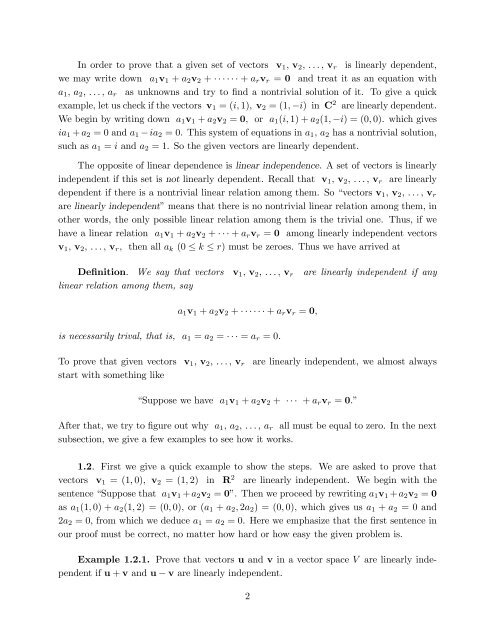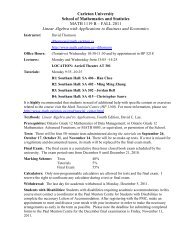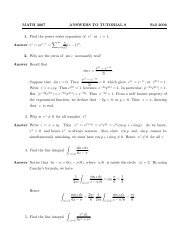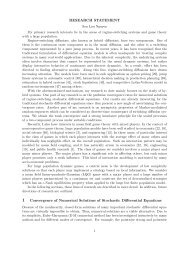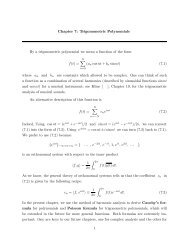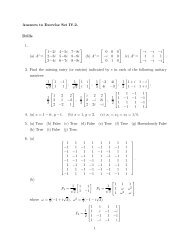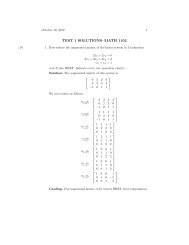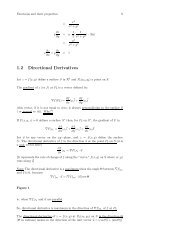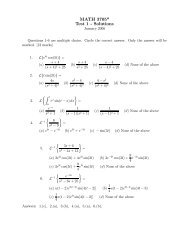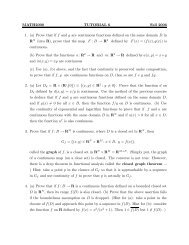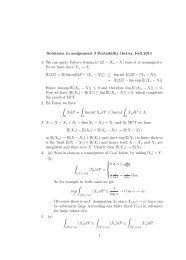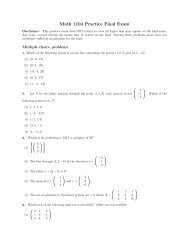CHAPTER II DIMENSION In the present chapter we investigate ...
CHAPTER II DIMENSION In the present chapter we investigate ...
CHAPTER II DIMENSION In the present chapter we investigate ...
Create successful ePaper yourself
Turn your PDF publications into a flip-book with our unique Google optimized e-Paper software.
<strong>In</strong> order to prove that a given set of vectors v1, v2, . . . , vr is linearly dependent,<br />
<strong>we</strong> may write down a1v1 + a2v2 + · · · · · · + arvr = 0 and treat it as an equation with<br />
a1, a2, . . . , ar as unknowns and try to find a nontrivial solution of it. To give a quick<br />
example, let us check if <strong>the</strong> vectors v1 = (i, 1), v2 = (1, −i) in C 2 are linearly dependent.<br />
We begin by writing down a1v1 + a2v2 = 0, or a1(i, 1) + a2(1, −i) = (0, 0). which gives<br />
ia1 + a2 = 0 and a1 − ia2 = 0. This system of equations in a1, a2 has a nontrivial solution,<br />
such as a1 = i and a2 = 1. So <strong>the</strong> given vectors are linearly dependent.<br />
The opposite of linear dependence is linear independence. A set of vectors is linearly<br />
independent if this set is not linearly dependent. Recall that v1, v2, . . . , vr are linearly<br />
dependent if <strong>the</strong>re is a nontrivial linear relation among <strong>the</strong>m. So “vectors v1, v2, . . . , vr<br />
are linearly independent” means that <strong>the</strong>re is no nontrivial linear relation among <strong>the</strong>m, in<br />
o<strong>the</strong>r words, <strong>the</strong> only possible linear relation among <strong>the</strong>m is <strong>the</strong> trivial one. Thus, if <strong>we</strong><br />
have a linear relation a1v1 + a2v2 + · · · + arvr = 0 among linearly independent vectors<br />
v1, v2, . . . , vr, <strong>the</strong>n all ak (0 ≤ k ≤ r) must be zeroes. Thus <strong>we</strong> have arrived at<br />
Definition. We say that vectors v1, v2, . . . , vr are linearly independent if any<br />
linear relation among <strong>the</strong>m, say<br />
a1v1 + a2v2 + · · · · · · + arvr = 0,<br />
is necessarily trival, that is, a1 = a2 = · · · = ar = 0.<br />
To prove that given vectors v1, v2, . . . , vr are linearly independent, <strong>we</strong> almost always<br />
start with something like<br />
“Suppose <strong>we</strong> have a1v1 + a2v2 + · · · + arvr = 0.”<br />
After that, <strong>we</strong> try to figure out why a1, a2, . . . , ar all must be equal to zero. <strong>In</strong> <strong>the</strong> next<br />
subsection, <strong>we</strong> give a few examples to see how it works.<br />
1.2. First <strong>we</strong> give a quick example to show <strong>the</strong> steps. We are asked to prove that<br />
vectors v1 = (1, 0), v2 = (1, 2) in R 2 are linearly independent. We begin with <strong>the</strong><br />
sentence “Suppose that a1v1 +a2v2 = 0”. Then <strong>we</strong> proceed by rewriting a1v1 +a2v2 = 0<br />
as a1(1, 0) + a2(1, 2) = (0, 0), or (a1 + a2, 2a2) = (0, 0), which gives us a1 + a2 = 0 and<br />
2a2 = 0, from which <strong>we</strong> deduce a1 = a2 = 0. Here <strong>we</strong> emphasize that <strong>the</strong> first sentence in<br />
our proof must be correct, no matter how hard or how easy <strong>the</strong> given problem is.<br />
Example 1.2.1. Prove that vectors u and v in a vector space V are linearly independent<br />
if u + v and u − v are linearly independent.<br />
2


